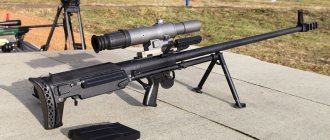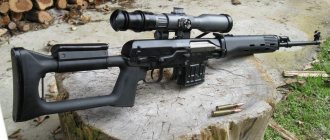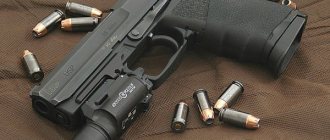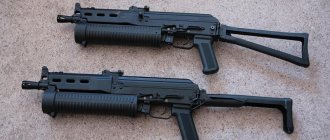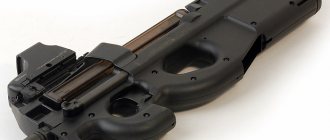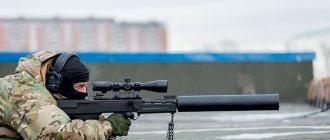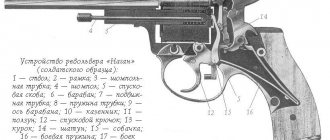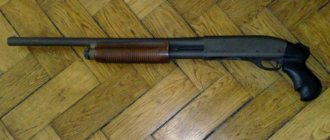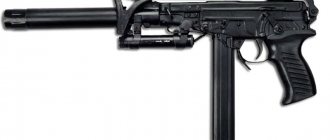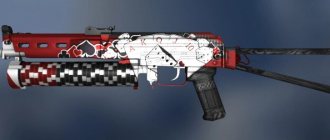After the end of World War II, American soldiers were armed with a number of rifles, among them there were quite successful examples, including the M1 Garand self-loading rifle. But due to a number of unsuccessful decisions during its creation, such as loading with a pack, the impossibility of replenishing the magazine until it was completely empty, and the diopter sight being extremely inconvenient in the twilight.
The M1 was replaced by a new automatic rifle - the M14, but due to the advent of an intermediate cartridge, it did not last long in linear units, moving into the category of sniper weapons.
History of appearance
It was not for nothing that the M1 “Garand” was considered the ideal weapon for an infantryman; General Patton himself praised it; American infantrymen and Marines trusted it with their lives throughout the Second World War and the Korean War, but it all comes to an end. This carbine also needed replacement. The servicemen were not satisfied with the batch loading of the Garanda, the overcomplicated automatic operation and the long stroke of the rifle piston, which significantly reduced the accuracy of fire.
In addition, automatic weapons entered the scene, while the Garand was a self-loading carbine. For this reason, in the late 40s and early 50s of the 20th century, the leadership of the US Army decided to create a new machine gun chambered for the new 7.62x51 mm cartridge.
It was adopted as a replacement for the overpowered .30-06 Springfield cartridge, and in 1954 it became the main NATO rifle cartridge. All well-known American manufacturers took part in the development: Winchester, Remington and Springfield.
The finalists of the competition held by the US Department of Defense included the T44 rifle, which operates on the principle of a short stroke piston, from the Springfield company and an analogue of the Belgian FN FAL, under the licensed name T48.
Despite the simpler design and better ergonomics, a national version of the weapon was adopted - the T44 automatic rifle, which was put into service in 1957 under the M14 brand.
Serial production began almost immediately after the rifle was put into service, but due to the large number of “childhood” diseases and the undeveloped technology, the series went extremely slowly; it is enough to note that in 1961 the weapons produced were only enough to completely re-equip one division. But after setting up production, work began, the US Army and Marine Corps were almost completely transferred to these carbines by the end of 1962.
The war in the jungle became her baptism of fire. The Vietnam conflict, which began for the United States in March 1965, involved more and more army units. Under these conditions, the M14 rifle performed quite well, but only as a self-loading carbine. The fighters noted the low accuracy of automatic fire and the heavy weight of the rifle; the diopter sight of the weapon also caused a lot of criticism.
At the same time, excellent characteristics and high efficiency and accuracy of the bullet were noted when firing single shots. It got to the point that rifles were delivered to units with the fire mode translator removed, this was explained by savings in ammunition and greater efficiency of firing in single mode.
There were also complaints about the wood of the butt and stock; the climate and high humidity practically ate away the protective varnish coating, after which the wood swelled and warped, further increasing the weight of the weapon; in addition, this often led to damage to the weapon. The situation was somewhat corrected by the introduction of fiberglass stocks.
Already in 1967, new “Armalits”, AR-15 rifles, which later received the name M16 and the nickname “black rifle,” began to be supplied en masse to US Army units.
The M14 was transferred to the rank of a sniper weapon, and in this capacity it remains in service to the present day.
Faced with Viet Cong troops armed with SKS carbines and AK-47s, the Americans fully appreciated the effectiveness of automatic fire. The M14 could not provide such density, while the effectiveness of bullets from 7.62x39 mm and 7.62 mm NATO cartridges in jungle conditions was quite comparable.
The M16 somewhat leveled the odds, but the M14 did not immediately go out of service; in a number of cases, it was its use as a target weapon that ensured the knockout of Viet Cong unit commanders.
The rifles were also supplied to US-friendly regimes, and they are also used by special units of the US Marine Corps in mountain and desert conditions. Where the low-pulse 5.56 mm cartridge showed its complete failure.
Automatic carbines for 6.5 mm Grendel could replace the M14, but fortunately the US Department of Defense does not have enough financial resources to completely transfer the army to new ammunition and weapons. And the stockpiles of old weapons accumulated during the Cold War are enough to arm men all over the world many times over.
Links
Rifles and machine guns M1 and Mark 2 • M1918 • • M14 • M15 • M16 • XM22/E1 • XM106 • XM70 • FN SCAR • HK416/M27 Carbines M1/M2 • XM177/E1/E2 and GAU-5/A • Colt Model 653 • M231 • M4/A1/E2 • GUU-5/P • Mark 18 Sniper rifles M14SE • M21 • M24 • M25 • M39 • M40 • M82 and M107 • M88 and Mark 15 • M110 • Mark 11 • Mark 12 • Mark 14 • DMR • RC-50 • SAM-R • SDM-R • M2010 Submachine guns Thompson • • Smith & Wesson M76 • MP5/K Guns Ithaca M37 • Remington 870 • Mossberg 500/590 • M1014 • XM26 Machine guns M60 series and Mark 43 • XM207/E1 and Mark 23 • M73/M219 • M85 • M240 • Stoner 63 • M249 series and Mark 46 • XM262 • XM312 • Mk 21 • EX 27 • Mark 48 • Browning M2 • GAU-19 • M134 Minigun • LW50MG • LWMMG Hand grenade launchers M79 • XM148 • M203 • M234 • M320 • M32 • EX 41 • Mark 13 Automatic grenade launchers M75/M129 • XM174 • Mark 19 • Mark 47 • XM109 • XM307 Other weapons XM25 • M20A1/A1B1 • M67 • M72 series • M136 (AT4) • M141 • M202/A1 • Mark 153 • FIM-43 Redeye • FIM-92 Stinger • FGM-172 SRAW • Ammo 7.62x33mm • 5.56x45mm NATO • 7.62x51mm NATO • .30-06 Springfield • 12.7x99mm NATO • .300 Winchester Magnum • 9x19mm Parabellum • .45 ACP • 12 gauge
The design and principle of operation of the M14 automatic rifle
The operating principle of the M14 is based on the use of the energy of burnt powder gases removed from the barrel bore and acting on a piston connected to the bolt frame. To minimize fluctuations in heated air above the barrel, the gas unit is located underneath it. The piston operates in a gentle mode, cutting off excess gases due to the holes in its chassis; the gas entering there compensates for the movement of the piston with back pressure.
The barrel is locked by turning the bolt with two stops entering the grooves on the chamber.
Food from metal 20-local box-type magazines with a double-row arrangement of cartridges. It should be noted that when using muzzle grenades, a 5-local magazine for blank cartridges can be attached, which differs from the standard one. The height of the magazine and overall length also caused complaints among military personnel.
Hunting and civilian weapons can be equipped with both standard army-type magazines and those shortened by 5-10 rounds.
The return spring is located under the barrel, in the stock, a trigger-type trigger, allowing both single and automatic fire. The M14 rifle has a bolt delay; after the magazine is completely empty, the bolt frame is retracted to position 33 and stops there, this ensures chambering of the cartridge when quickly changing the magazine.
The stock and butt of a classic type weapon is made of polymer materials or hardwood. On top of the barrel there is a barrel pad that saves the shooter’s hands from burns; on a number of samples, to make the weapon lighter, the pad is made of a metal plate with holes for lightness and ventilation.
The stock of a light machine gun based on a rifle is distinguished by the presence of a pistol grip for fire control, a folding tactical handle and a mount for a bipod.
Buttstocks and stocks for M14-based sniper rifles are produced in a wide range by private contractors and are extremely diverse.
A flash suppressor is installed at the muzzle of the barrel; on some weapons, its design allows it to be used for throwing tromblon barrel grenades, and lugs for attaching a standard bayonet.
Cannot be used with an under-barrel grenade launcher.
Aiming using a mechanical sight, which consists of a diopter rear sight on the breech of the weapon and a front sight on the block, near the muzzle of the barrel.
Design
The M14 rifle is a magazine-fed automatic weapon with an automatic gas engine. The gas outlet unit is fixed under the barrel, the gas piston is made in the form of a glass and has a short stroke. In this case, gases are supplied into the gas piston through a hole in the barrel and a hole in the piston wall, and after the piston moves back a few millimeters, the supply of gases into the piston is automatically shut off, thereby cutting off “extra” gases and softening the operation of the automation. The gas piston does not have its own return spring. It acts on the bolt frame located under the barrel, which is connected to the rotary bolt by a long lever. The design of the bolt is similar to that of the M1 Garand; it locks the barrel by turning to the right onto 2 lugs that fit into the cutouts of the receiver. The usual bolt lug that interacts with the bolt carrier is replaced in the M14 with a roller to reduce wear. The return spring is located under the barrel and acts on the bolt frame. The trigger mechanism is a trigger mechanism, similar to the M1 Garand, but with the addition of a mechanism that allows burst firing. and a fire mode translator on the right side of the receiver, above the trigger. On the left side of the receiver there is a bolt stop that stops the bolt in the open position after all the cartridges in the magazine have been used up. The magazines are box-shaped, detachable, double-row, 20 rounds. The magazines can be loaded without disconnecting from the weapon using standard 5-round clips, for which guides for the clips are made on the top of the receiver. The safety lever is located in the front part of the trigger guard. Sights - an adjustable diopter rear sight on the rear of the receiver and a front sight in the front sight on the muzzle of the barrel.
The barrel is equipped with a slotted flash hider and has a bayonet mount
The barrel is equipped with a slotted flash suppressor and has a bayonet mount. The stock is wooden, with a semi-pistol grip and a metal top plate on the barrel. The M14A1 rifles have a stock of a different design - wooden with a pistol grip and a butt raised to the line of the barrel. The M14A1 forend has a folding front handle, a light bipod is attached to the gas chamber, and a special removable muzzle brake-compensator is attached to the flash suppressor.
Specifications
| Characteristics | M14 | SVT-40 | SCS |
| Cartridge | 7.62x51 | 7.62x53R | 7.62x39 |
| Shop | Detachable, 20 | Detachable, 10 | Permanent, 10 (equipment from clips) |
| Overall length, mm | 1120 | 1226 | 1020 |
| Barrel length, mm | 560 | 625 | 520 |
| Weight, kg | 5,1 | 4,1 | 3,9 |
| 3,9 | 50-60 | 20-25 | 35-40 |
| Effective range, m | 600-800 | 600-800 | 400-600 |
Weapon options
The M14 was and is produced in dozens of variants, the most common are the following military modifications of this automatic rifle:
- M14A1 – light machine gun, changes affected only the rifle stock, two handles and a bipod were added;
- M21 – sniper model M14, a self-loading rifle with a weighted barrel and a bracket for mounting an optical sight;
- M25 Sniper Weapon System, a sniper version of the rifle, an analogue of the SVD, with a polymer stock of a modified design and equipped with a pre-installed RIS interface;
- Mk.14 Mod.0 Enhanced Battle Rifle, weighted barrel, modified stock, stock, RIS interface;
- M39 Enhanced Marksman Rifle, the basis of the M14, US Marine Corps Army sniper rifle, combat range 300-600 meters.
In addition, various types of civilian and hunting versions of this weapon were produced, the most famous of which is the M14M of the Springfield Arsenal, its main and only difference from a combat rifle is the presence of only a single firing mode.
Currently, the Chinese versions of the M14 from Norinco and the Taiwanese type 97 are widespread.
They are distinguished from army models only by the wood of the stock and butt, the absence of automatic fire modes and the presence of pre-installed rails for mounting optics.
In addition, it is worth noting that if Norinco products are of quite acceptable quality, then it is difficult to say about other clones; when purchasing a civilian M14 model from another company, you need to pay close attention to the quality of its manufacture.
Notes
- N. R. Andreev, N. I. Grishin. US Army Infantry Battalion. M., Voenizdat, 1964. p.39
- USA // “Master Gun” magazine, No. 7 (76), June 2003. p. 24
- A.E. Hartink. Army weapons: a modern illustrated encyclopedia. M., “Labyrinth Press”, 2005. p.277
- A.E. Hartink. Army weapons: a modern illustrated encyclopedia. M., “Labyrinth Press”, 2005. p.276
- [luxdeftec.eu/ldt%20products/ldt%20m14/ldt%20m14%20standard.html LDT M14] / official website of “Luxembourg Defense Technologie SA”
- Springfield Armory continues to improve the M-14 assault rifle // Master Gun magazine, No. 6 (99), June 2005. p. 6
- [www.mil.ee/et/kaitsevagi/tehnika/relvad/Tapsuspyss-M14-TP Täpsuspüss M14-TP] / official website of the Estonian Ministry of Defense
- in the 1990s, in accordance with the order of US President Bill Clinton, weapons and equipment worth $1.2 million were transferred from army warehouses to the police, including 185 pieces. M-14 Brad Lockwood automatic rifles. [www.forbes.com/sites/bradlockwood/2011/11/30/the-militarizing-of-local-police/ The Militarizing of Local Police] // Forbes November 30, 2011
- ↑ 1 2 3 4
[www.imageseek.com/m1a/M14RHAD060113%20web%20site.doc M14 Rifle History.] (unavailable link since 08/12/2013 (3086 days) -
history
,
copy
) Retrieved on September 24, 2008 . - E. Sokolov. Israeli Ground Forces // “Foreign Military Review”, No. 4, 1990. pp. 21-27
- [world.guns.ru/assault/as15-r.htm M.R. Popenker. Rifle M14 / Mk.14 Mod.0 (USA)]. [www.webcitation.org/65WomDQEg Archived from the original on February 18, 2012].
- [bemil.chosun.com/nbrd/gallery/view.html?b_bbs_id=10044&num=111149 자유사진자료실.] Retrieved on September 24, 2008.
- Dial Torgenson. Arms for everywhere. Central America caught in race to escalate power // The Milwaukee Journal, January 23, 1983. page 2
- Martha Honey. Hostile Acts: US Policy in Costa Rica in the 1980s. University Press of Florida, 1994. page 299
- Major Richard J. Anderson. [www.dtic.mil/dtic/tr/fulltext/u2/a500256.pdf US Security Assistance For Estonia]. p.8
- “ When discussing the topic of small arms, the Latvian military immediately recalls the existence of the Law “On State Secrets.”
As the head of the logistics working group of the Ministry of Defense of Latvia, Colonel-Lieutenant Zemessardze Imants Tsirulis, said... some of its types at the disposal of the Latvian army are American automatic rifles M-16 and M-14 , assault rifles and Kalashnikov machine guns
" [www.delfi.lv /biznes/bnews/latviya-aktivno-torguet-oruzhiem.d?id=1915093 Latvia is actively trading in weapons] // DELFI.LV dated October 5, 2001 - Vladimir Vodo. [kommersant.ru/doc/171079 The Lithuanian army adopted rifles from someone else’s shoulder] // Kommersant, No. 41 (2171) dated March 07, 2001
- [kariuomene.kam.lt/lt/ginkluote_ir_karine_technika/automatiniai_sautuvai/automatinis_sautuvas_m-14.html Automatinis šautuvas M-14] // website of the Ministry of Defense of Lithuania
- Julio A. Montes. [sadefensejournal.com/wp/?p=952 El Salvador: Standing tall] // “Small Arms Defense Journal” vol.3 No.4 dated January 12, 2012
- S. Smirnov. With the world on a thread. The US Department of Defense will donate 40,500 M14 assault rifles to the Estonian Defense Forces, the US Embassy in Estonia announced. // “Merchant Newspaper” dated August 6, 1998
- [worldinventory.googlepages.com/wiw_eu_estonia World Infantry Weapons: Estonia.]
Combat use
If initially things didn’t go particularly smoothly for the M14 as a weapon for line units, then when it was used as a standard weapon for army snipers, everything brightened up. At a distance of 300-600 meters, which are the main ones for infantry units, it is the density of fire that plays a big role, and not the accuracy of the shot. Self-loading sniper rifles are more suitable for this role than slow but accurate bolt-action rifles.
As a light machine gun, the M14 also did not show good results. The reasons for this are firing from a closed bolt, low rate of fire, a non-replaceable barrel and a small magazine.
In addition to the United States, friendly regimes in Third World countries were also armed with these weapons, the new American M14 rifles.
A fairly simple, reliable and effective weapon, albeit with powerful ammunition, fully met the requirements of such states.
The Vietnam War showed that the M14, as an infantry weapon, did not perform particularly well in combat; the main complaints about the rifle were:
- large weight and dimensions of the weapon;
- small supply of portable ammunition;
- low accuracy of automatic fire;
- diopter sight, which narrows the field of view and is poorly suited for working in dark conditions;
- stores of small volume, in addition having significant weight.
But these shortcomings are not decisive for a sniper rifle. As a target weapon, the M14 proved to be simply excellent, creating a high density of fire in the area; in addition, having good accuracy and shooting accuracy, the M14 quickly won the trust of snipers.
Once in the hands of army snipers, the rifle went through a long and difficult journey from Vietnam to the present day. Today, sniper rifles based on it serve in both the US Army and the Marine Corps. Moreover, the M14 is being mastered by Air Force sappers and special forces units that require powerful and high-precision weapons for combat at medium distances.
The intermediate cartridge, despite all its advantages in terms of the mass of ammunition and the lightness of the weapon, is ineffective in mountainous or desert conditions; in this case, heavier bullets of powerful rifle and machine gun cartridges perform much better.
For this reason, M14s were removed from arsenals and adopted by various types of special units during operations to impose democracy in the Middle East. Where M16 and M4 showed their inconsistency.
In addition, the M14 is still used as a ceremonial weapon, along with the outdated Garands and Springfields.
These are parades, fireworks and rituals. So the M14 is used by combat units of the army and navy during the ceremony at Arlington Cemetery, for salutations at send-offs and in other fun, and not so fun, ceremonies.
The M14 is a rather interesting weapon. Having entered service as a linear infantry rifle, the M14 did not find use, but at the same time it became widespread as a weapon for marksmen and snipers.
Civilian weapons based on it are also widely known. Similarities and clones of the M14 are being produced all over the world, from China to Venezuela. The M14 automatic rifle has become widespread as a high-power weapon chambered for a rifle cartridge, with reliability and good accuracy of fire.
Users[edit]
- Australia: Used by the Special Air Service Regiment in operations against the Taliban. [20] [21]
- Iraq: Iraqi Special Operations Forces [22]
- USA [23]
- Philippines: Ferfrans variant used in the Philippine National Police Special Forces Action[ edit
] - Taiwan [ link needed
]
Non-state actors[edit]
- Harakat Nur ad-Din al-Zenki [24]
- Islamic State [25]

